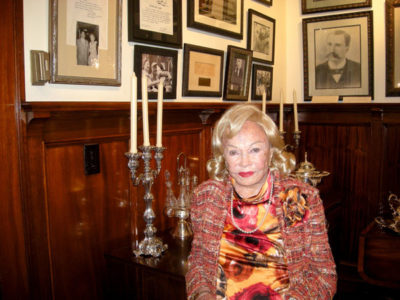Ace Hearst reporter, Patte Barham keeps on writing

PHOTOS of newsmakers she has known surround Patte Barham at her Fremont Place home.
In the classic 1940s comedy “His Girl Friday,” Rosalind Russell plays Hildy Johnson, an ace female crime reporter who can out-scoop any male ink slinger within miles. There have been many real-life Hildys populating the annals of post WWII journalism, but odds are none have lived as colorful a life as Patte Barham, a diminutive dynamo with decades of experience in the news game.
The longtime Fremont Place resident is a petite, perfectly-coiffed force of nature who strongly believes that a person’s age does not define them. “Don’t ever get locked into a number,” she advises.
Patricia Ann (“Patte”) Barham is a native daughter of California. Her father, Frank Barham, was a newspaper magnate and L.A. booster who donated the land that later became Barham Boulevard. Because of the close friendship between Patte’s father and the publisher William Randolph Hearst, she grew up in the splendor of Hearst’s castle in San Simeon, rubbing elbows with Charlie Chaplin and actress Marion Davies, whom Patte called “Aunt Marion.”
The precocious blonde knew she wanted to be a writer from an early age. Her first publication in 1945 was “Pin-up Poems,” a collection of verses and cartoons for soldiers overseas. Confident and fearless, Patte had what it took to be a reporter. She also knew that the newspaper business was a man’s world, but she wanted in. “All my life I’ve fought for women’s rights,” she says now. “That’s what I’m proudest of.”
Hearst finally gave Patte a chance, along with this warning: “Get the story—you’re hired. If you don’t—you’re fired!” Those words became her mantra.
Other early champions included reporter and columnist Bob Considine. He was my idol,” Patte says fondly. “He’d say things like ‘Keep it up, kid!’ or ‘You LOOK like a reporter, now go gettum!’”
And so she did. To investigate a hospital lab conducting illegal experiments on animals, Patte and a female photographer got the scoop by posing as doctors’ wives, with cameras hidden in their floral bouquets. “Getting that first story was a baptism of fire.”
Her reverence for animals is evident in how she speaks of her own menagerie, six champion Skye terriers and two adopted cats. When the rookie teen scribe helped break a high-profile murder case, and it was feared the gang responsible would go after her, Hearst hid her on his estate near Mt. Shasta until “the heat cooled off.”
In 1951, Hearst sent her to Korea to cover the war. As the only female reporter on the front lines, knocking out scoops from her rain-drenched tent, Patte was in the thick of it: covering the battle of Pork Chop Hill, climbing Heartbreak Ridge, and even hitching a ride in a fighter plane.
Back from Korea, she filed syndicated stories on some of L.A.’s most notorious crimes and trials, including the Thelma Todd murder. Her war experiences became fodder for her first book, “Operation Nightmare”—which was followed by Rasputin: The Man Behind the Myth” (co-authored with Rasputin’s daughter Maria, a close friend); and “Marilyn: The Last Take.” (a “red hot” bestseller on the last weeks of Marilyn Monroe).
Patte shows no signs of slowing down. Currently, she is working on the manuscripts for three books with long-time collaborator Robert Wood, her friend of 40 years.
A prestigious array of awards and honorary degrees fill the walls in the dining room of the home she shares with husband Jim Inman. Also on display are countless framed, autographed photos of luminaries from Charlie Chaplin to Gen. Douglas MacArthur, as well as an imposing portrait of the fabled Hearst, all eloquent testimony of an adventurous life lived on her own terms.
So what is the secret to Patte’s boundless energy, creativity and vitality? What made her William Randolph Hearst’s “number one press gal?” A potent mixture of good genes, good humor and moxy—and it didn’t hurt to be able to look equally at home in a foxhole wearing fatigues, or an evening gown at the Cocoanut Grove.
Category: People


